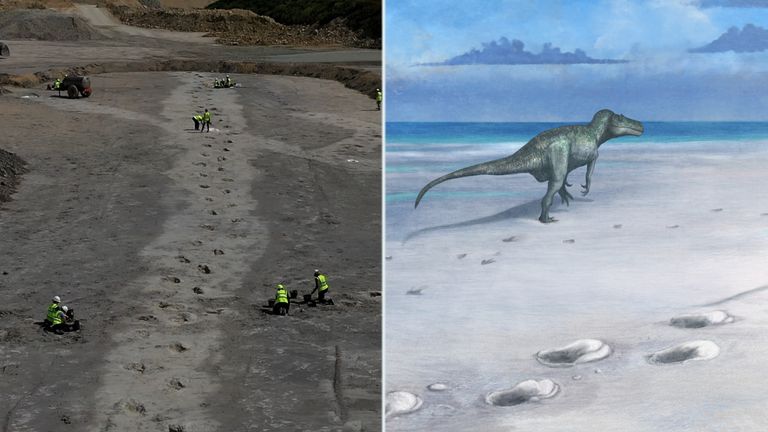
Massive Dinosaur Footprint Discovery in Oxfordshire Reveals Secrets of Jurassic Life
A groundbreaking discovery in Oxfordshire has unveiled one of the largest and most significant dinosaur footprint sites ever found in the UK. Over 200 ancient footprints, dating back approximately 166 million years, have been uncovered in Dewars Farm Quarry, offering an extraordinary glimpse into the movements and behaviors of dinosaurs from the Middle Jurassic period. These tracks, left behind by two distinct types of dinosaurs, have provided invaluable insights into the prehistoric world.
The trackways span an impressive 150 meters in length, though they may extend even further, as only part of the quarry has been excavated. The footprints were made by two prominent dinosaurs: the plant-eating sauropod Cetiosaurus and the carnivorous Megalosaurus. Cetiosaurus, a massive long-necked herbivore that could reach up to 18 meters in length, left behind large, elephant-like footprints. Meanwhile, the smaller Megalosaurus, a fierce predator that grew up to 9 meters in length, left distinct three-toed prints, providing researchers with a fascinating contrast between the giant herbivores and their agile, meat-eating counterparts.
The discovery came when Gary Johnson, a worker at the quarry, noticed unusual bumps in the ground while operating a digger. Upon further investigation, it became clear that these were not just irregularities but ancient footprints. The realization that these marks were made by dinosaurs sent a thrill through Johnson, as he realized he was the first person in millions of years to see them.
Also Read:- Softchoice’s Acquisition and TSX Exit: Key Insights on the $1.8 Billion Deal
- Deadly Terror Attack in New Orleans: A Tragic Start to the New Year
A team of over 100 scientists, volunteers, and students joined forces for the excavation, which took place over the summer of 2024. The team meticulously documented over 200 footprints and created detailed 3D models of the trackways using drone photography. This allows for a deeper understanding of how these ancient creatures moved and interacted in their tropical lagoon habitat.
One of the most exciting aspects of the discovery is a section where the tracks of a sauropod and a Megalosaurus appear to have crossed paths. The preservation of these prints is so detailed that researchers can tell which animal passed through first. It is believed the sauropod left its tracks first, with the Megalosaurus's smaller prints clearly superimposed over them.
For scientists like Professor Richard Butler from the University of Birmingham, this site offers a wealth of information. The detailed footprints allow for a closer look at how dinosaurs moved and interacted with their environment. The team believes that the tracks were preserved due to a sedimentary event, such as a storm, that covered the footprints before they could be washed away.
As researchers continue to study the site, they hope to uncover even more evidence of prehistoric life, offering a snapshot of the Jurassic world as it was millions of years ago. The excavation is set to be featured in the upcoming series of Digging for Britain on BBC Two, and the discovery will also be part of the new "Breaking Ground" exhibition at the Oxford University Museum of Natural History. This remarkable find is a testament to the ongoing fascination with dinosaurs and their place in Earth's history.
Read More:



0 Comments